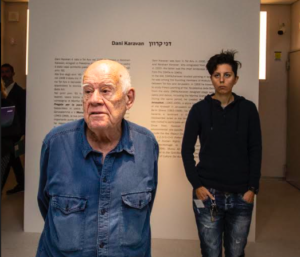When the Israeli sculptor Dani Karavan built in Ferrara the garden that doesn’t exist
 Israeli artist Dani Karavan passed Saturday in Tel Aviv, where he was born in 1930. Famous for his poignant monuments in Israel and around the world, Karavan had a particular relationship with Italy, born at the time he was studying Fresco painting at the Academy of Fine Arts in Florence. Master of environmental art, he was the author of some of the most important artworks in Israel such as the huge wall carving in the hall of the Knesset, named Pray for the Peace of Jerusalem, 1965-1966) and his first site specific environmental sculpture – the Negev Monument (Be’er Sheva, Israel 1963-1968), which became a landmark in Environmental Art.
Israeli artist Dani Karavan passed Saturday in Tel Aviv, where he was born in 1930. Famous for his poignant monuments in Israel and around the world, Karavan had a particular relationship with Italy, born at the time he was studying Fresco painting at the Academy of Fine Arts in Florence. Master of environmental art, he was the author of some of the most important artworks in Israel such as the huge wall carving in the hall of the Knesset, named Pray for the Peace of Jerusalem, 1965-1966) and his first site specific environmental sculpture – the Negev Monument (Be’er Sheva, Israel 1963-1968), which became a landmark in Environmental Art.
Dani Karavan was commissioned to create environmental sculptures in Israel, France, Germany, United States, Korea, Taiwan and Japan to name a few. He exhibited in numerous museums around the world and is a recipient of prestigious international awards. Among his last exhibitions there was the one in Italy, at the MEIS – National Museum of Italian Judaism and the Shoah in Ferrara, where the then director Simonetta Della Seta had called him. It was 2018, the 80th anniversary of the promulgation of racist laws. “The Garden that doesn’t exist” is a site-specific project, which represents Karavan’s homage to Giorgio Bassani’s book The Garden of the Finzi Continis.
“I came to Ferrara for the first time in 1956 to see the frescoes by Francesco del Cossa and Cosmé Tura”, he said. “I fell in love with the city and have been back many more times since then. In the 1980s I met Paolo Ravenna there and a friendship immediately broke out. Thanks to him, I discovered the Jewish side of Ferrara and the story of Giorgio Bassani. The idea of The Non-Existent Garden came to me when I ran into a group of Americans looking for the Finzi-Continis garden behind a wall in Corso Ercole I d’Este without finding anything”.
So, why not use that wall in Corso Ercole I d’Este to create the entrance into a void, into the garden that is not there? he thought. Gradually, explained Karavan, the suggestion became clearer, outlined, populated with objects. Here, then, is a railway, with the dual function of physically giving the public access to that place, now no longer just mental, and of remembering the tragic fate of the many Italian Jewish families who by train went to meet their death, deported by the Nazis to Auschwitz and in other extermination camps.
“I remember those days as a gift, an unforgettable experience”, Della Seta explains to Pagine Ebraiche. “I had met Karavan years before, in Israel. What struck me was not only the greatness of his artistic investigation. But also that simplicity in the ways that is typical of all the great ones “.
Some of the most celebrated works by Dani Karavan include Axe Majeur (1980-ongoing, Cergy Pontoise, France), Passages – Homage to Walter Benjamin (1990-1994, Portbou, Spain), Murou Art Forest (1998-2006, Murou, Japan), Memorial to the Sinti-Roma (1999-2012, Berlin Germany), Square of Culture (2005-2012, Tel Aviv, Israel) and White Square (1977-1988, Tel Aviv, Israel). He has exhibited in numerous museums around the world and is a recipient of prestigious international awards, such as the Israel Prize (1977); Silver Medal for Plastic Arts of the French Academy of Architecture (1992); Goslar Kaiser Ring for Visual Art, Germany (1996); the first Unesco’s Artist of Peace (1996); Praemium Imperiale – the Nobel Prize for the Arts, Japan (1998); the Goethe Medal, Germany (1999); Premio Michelangelo, Carrara, Italy (2005); Knight of the French “Légion d’Honneur” (2014) among others.
(Above, the Israeli sculptor Dani Karavan during a visit at the MEIS. Image by Marco Caselli Nirmal)
